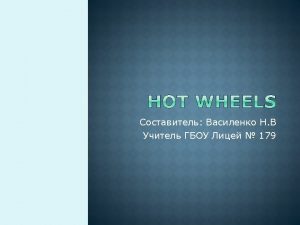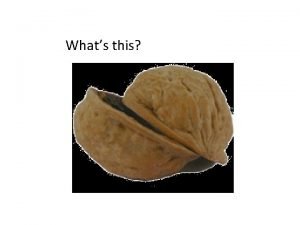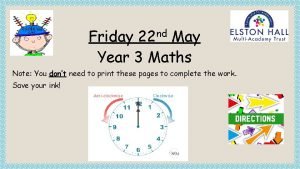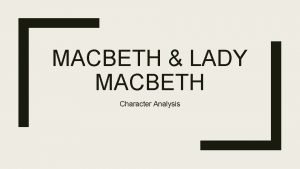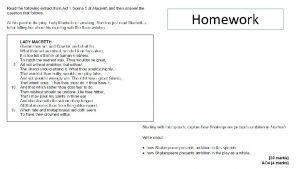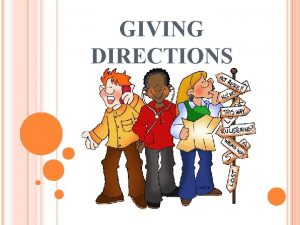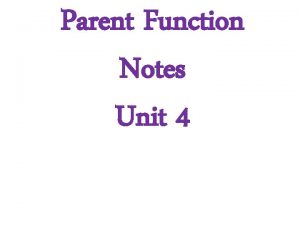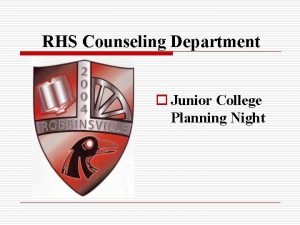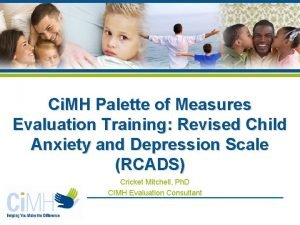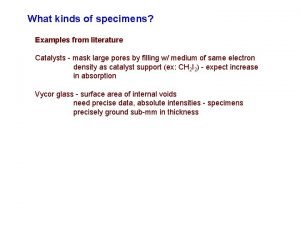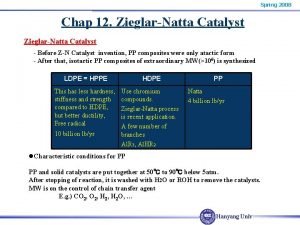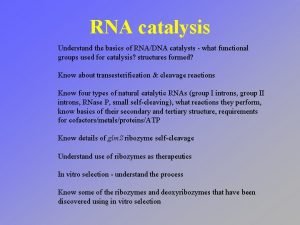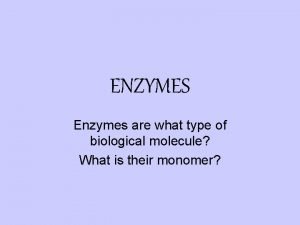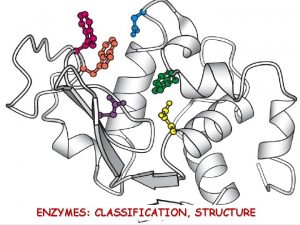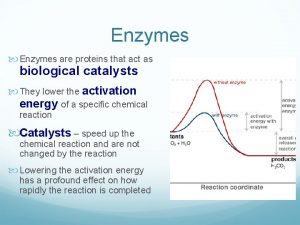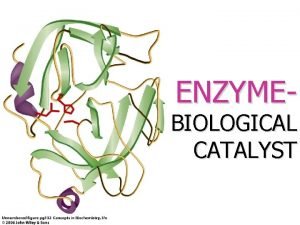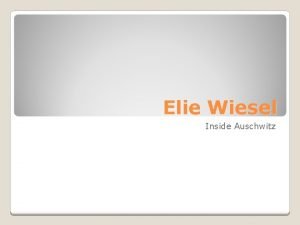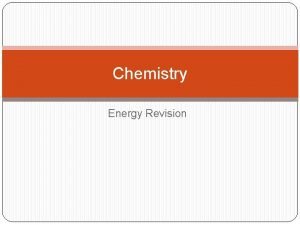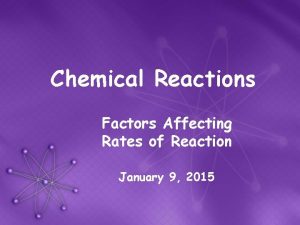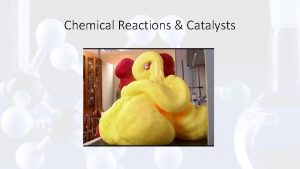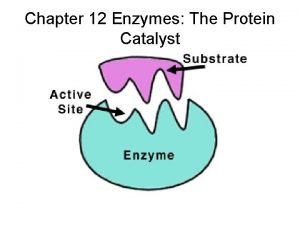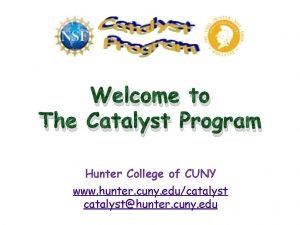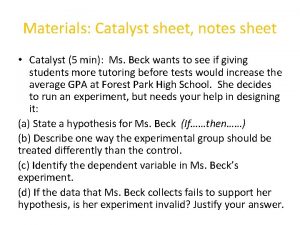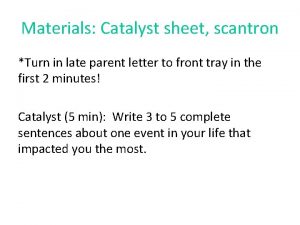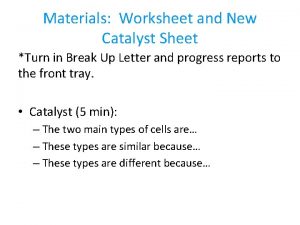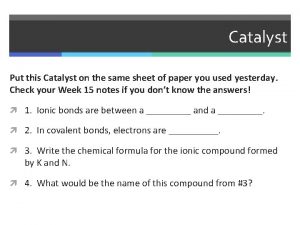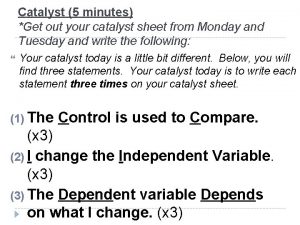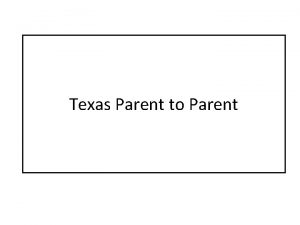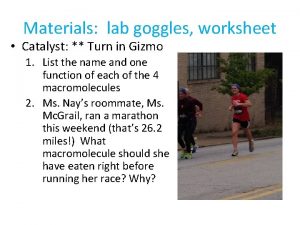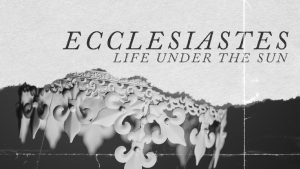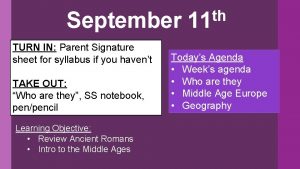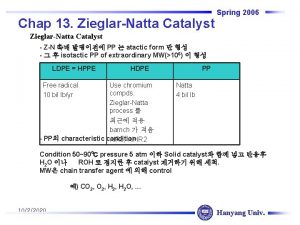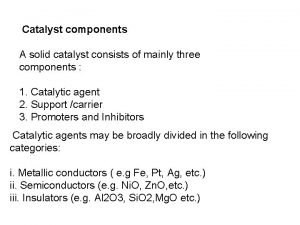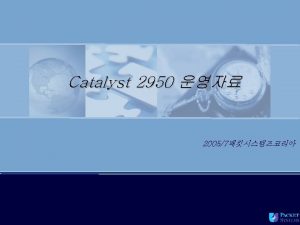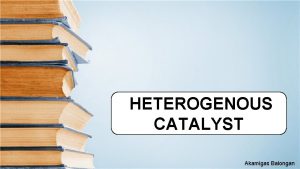Materials Catalyst sheet notes sheet Turn in parent





































- Slides: 37

Materials: Catalyst sheet, notes sheet *Turn in parent letter to front tray. Catalyst (5 min): In the following code, each symbol stands for two possible letters: + stands for I or A * stands for B or W = stands for C or T & stands for E or K ? stands for L or H The five-letter code word * ? + = & can be translated into two English words, and each one means the opposite of the other. What are the two words?

Materials: none *Turn in Parent letter to Blue Tray *Get out notes/independent practice from yesterday and place on your desk Catalyst: 1. How many different nitrogenous bases make up DNA? 2. What is the structure of DNA called? 3. What type of macromolecule is DNA considered?

Elite Eight Trait Check-Up 1. Respect the Threshold 1. Everyone on time? 2. Silent for First Five? 2. Be Prepared (2 min) 1. Seated 2. Have materials 3. Working on catalyst

Class Motto If there is a problem, We look for a solution. If there is a better way, We find it. If we need help, We ask. If a teammate needs help, We give.

Announcements • Parent Letter Due TOMORROW • No tutorial today!

Objectives I can explain the function of DNA in cells. I can draw and label the structure of DNA. I can name the 4 nitrogenous bases in DNA. I can calculate percentages of bases in a strand of DNA. • I can replicate strands of DNA. • •

*Note: NOT included in GN DNA Review 1. What part of the cell is genetic information (DNA) found? The nucleus 2. Describe the organization of DNA starting with its simplest form using the terms: DNA, Chromosomes, and genes DNA Genes Chromosomes 3. How many chromosomes do you get from each of your parents? 23 from your mother and 23 from your father

Watson & Crick Franklin Nature 1953

*Note: NOT included in GN The Organization of DNA Genes Chromosomes

*Note: NOT included in GN

DNA (Notes) What is DNA? – DNA: deoxyribo nucleic acid – DNA carries genes – DNA is the directions for making ALL the proteins in our bodies. Proteins control EVERYTHING!

What does DNA do? The fly’s eyes in this picture are different colors because they have different DNA that codes for proteins that make eye color.

DNA What does DNA look like? – DNA looks like a twisted ladder – The structure of DNA is called a double helix – This means that DNA has 2 strands – DNA is made of nucleotides

What does DNA look like? – DNA has 3 parts: 1. Sugar (deoxyribose) 2. Phosphate groups Sugar & phosphate 3. Nitrogenous base – The backbone (side of the ladder) is made of sugar and phosphate • They are kept together with strong phosphodiester bonds – The rungs are made of the bases – They are kept together with weak hydrogen bonds bases

DNA (THINK) • • What does DNA look like? What forms the “backbone” of DNA? Where are the weak bonds in DNA? Why do you think DNA is important?

Nitrogenous Bases • There are 4 bases in DNA nucleotides 1. Adenine 2. Thymine 3. Guanine 4. Cytosine

Nitrogenous Bases The order of the bases tells the ribosome what proteins to make

Nitrogenous Bases • The four bases always pair up so: o A ALWAYS goes with T o G ALWAYS goes with C This means that in a piece of DNA, there are equal amounts of A & T and G & C

DNA (THINK) • How do the bases always fit together? • If there are 10 thymines in a strand of DNA, how many adenines are there? • How does DNA carry its message?



Independent Practice • Complete # 1 -13 on DNA and Replication Independent Practice located on the back of your worksheet.

Panther Pass Procedure • Put away all notes. • Get out a half sheet of notebook paper (save the other half for next time or share with a friend!) • Write your name, date, class period, and panther pass at the top right. • No talking or your exit ticket will be taken away = ZERO!

Panther Pass 1. 2. 3. 4. 5. 6. What is the function of DNA? How many different bases make up DNA? What does A always pair with? What does C always pair with? What is the structure of DNA called? What macromolecule is DNA considered? A. B. C. D. Carbohydrate Lipid Nucleic acid Protein

Calculating %s of Bases Let’s say you know that 10% of the nucleotides in a strand of DNA are adenine. How could you figure out what percent are composed of the other nucleotides?

Calculating %s of Bases Example: a strand of DNA is 10% adenine. What percent guanine is it? REMEMBER: %A = % T , %G = % C THINK: %A + %T + %C + %G = 100%

Calculating %s of Bases Example: a strand of DNA is 10% adenine. What percent guanine is it? • Step 1: Write the percent for the complementary nucleotide • 10% A = • Step 2: Write the percent for the other 2 nucleotides %A + %T + %C + %G = 100% Step 3: Find what the question is asking • What percent guanine is it?

WE DO: • If a DNA strand is 33% G, what percent of it must be C? • What percent of it must be A?

DNA REPLICATION

DNA Replication • Before a cell goes through meiosis or mitosis, its DNA must make a copy • DNA Replication: a new copy of DNA is made from an old one. • DNA replication is important because our cells need 2 copies of DNA to reproduce

DNA Replication • Sometimes this proteins makes mistakes called mutations. • Mutation = change in DNA • Mutation leads to VARIATION! Think: What are some other places where we see variation?

Writing the Replicated Strands of DNA • REMEMBER: A pairs with: G pairs with: T C If a strand of DNA is: G C G T A T C G The copied strand is: C G C A T A G C

Writing the Replicated Strands of DNA • REMEMBER: A pairs with: C pairs with: T G If a strand of DNA is: G C G T A T C G The copied strand is: C G C A T A G C

DNA Replication If a strand of DNA is: A T C C T G C T The copied strand is: T A G G A C G A If a strand of DNA is: C C T T A G C T The copied strand is: G G A A T C G A

Panther Pass Procedure • Put away all notes. • Get out a half sheet of notebook paper (save the other half for next time or share with a friend!) • Write your name, date, class period, and panther pass at the top right. • No talking or your exit ticket will be taken away = ZERO!

Panther Pass 1. 2. 3. 4. 5. 6. What is the function of DNA? How many different bases make up DNA? What does A always pair with? What does C always pair with? What is the structure of DNA called? What macromolecule is DNA considered? A. B. C. D. Carbohydrate Lipid Nucleic acid Protein

Panther Pass 7. If a DNA strand is 44% Cytosine, how much of it is Adenine? 8. Replicate the following DNA strand: ATC GCT
 You can't turn right here. you turn left.
You can't turn right here. you turn left. I throw my warlike shield
I throw my warlike shield Answer. go straight turn left turn right
Answer. go straight turn left turn right Turn the arrow 1/4 turn clockwise
Turn the arrow 1/4 turn clockwise What does o valiant cousin worthy gentleman mean
What does o valiant cousin worthy gentleman mean Macbeth seeing banquo's ghost quote
Macbeth seeing banquo's ghost quote Turn left go ahead
Turn left go ahead Turn hell hound turn
Turn hell hound turn C172 vacuum system
C172 vacuum system One quarter turn clockwise
One quarter turn clockwise Walk straight and turn left
Walk straight and turn left Linear parent function graph
Linear parent function graph Parent brag sheet sample answers
Parent brag sheet sample answers Rcads scoring excel sheet child
Rcads scoring excel sheet child Favourite cars
Favourite cars Useful and harmful materials found at home
Useful and harmful materials found at home Natural materials and man made materials
Natural materials and man made materials What is adopting materials
What is adopting materials Direct materials budget with multiple materials
Direct materials budget with multiple materials Facteur g
Facteur g Xxxx website
Xxxx website Catalyst literature
Catalyst literature Wintergirls chapter summary
Wintergirls chapter summary Ziegler natta catalyst is
Ziegler natta catalyst is Rna catalyst
Rna catalyst Poem about catalyst
Poem about catalyst Finely divided catalyst
Finely divided catalyst What is a biological catalyst
What is a biological catalyst Enzymes classification
Enzymes classification Protein that acts as biological catalyst
Protein that acts as biological catalyst Examples of transferases
Examples of transferases What does wiesel mean when he says anger must be a catalyst
What does wiesel mean when he says anger must be a catalyst Christ catalyst
Christ catalyst Does a catalyst affect enthalpy
Does a catalyst affect enthalpy What is catalyst and how it affects reaction rate
What is catalyst and how it affects reaction rate Inorganic catalyst vs enzyme
Inorganic catalyst vs enzyme Catalyst protein
Catalyst protein The catalyst
The catalyst
